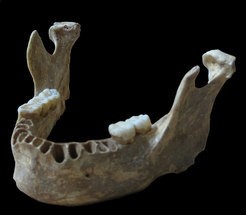Earliest Modern European had a close Neandertal ancestor

DNA taken from a 40,000-year-old modern human jawbone reveals that this man
had a Neandertal ancestor as recently as four to six generations back.
On the human scale, 5,000 years are an eternity, yet it is only the blink of an eye when it comes to life on earth. For 5,000 years at the maximum, but probably for a far shorter time, modern man and Neandertals were living together side by side in Europe.
Neandertals contributed on average one to three percent to the genomes of present-day Eurasians. Researchers have now analyzed DNA from a 37,000 to 42,000-year-old human mandible from Oase Cave in Romania and have found that six to nine percent of this person’s genome came from Neandertals, more than any other modern human sequenced to date. Because large segments of this individual’s chromosomes are of Neandertal origin, a Neandertal was among his ancestors as recently as four to six generations back in his family tree. This shows that some of the first modern humans that came to Europe mixed and interbred with the local Neandertals.
In 2002, a 40,000-year-old jawbone was found by cavers in Oase Cave in south-western Romania and the site was subsequently studied by an international team led by the researchers of the “Emil Racoviţă” Institute of Speleology in Romania. A second piece which had been found in the cave, an almost completely preserved skull, and this, the scientists did not dare to touch: "This one is too beautiful to be damaged," says Svante Pääbo, of the Max- Planck Institute for Evolutionary Anthropology in Leipzig (Germany).
The Romanian finds had awoken the interest of paleoanthropologists as soon they were discovered – not only because they count among the earliest remains of modern man in Europe, but also because the skull has some unique features. True, the marked chin and the high round skull top show him to be doubtlessly of a modern human. But the powerful bone plates behind the ears and the big teeth remind of the Neandertals.

Pääbo travelled in 2009 to Bucarest in order to take some samples. But his first attempt to find out the ancestry of the Romanian cave man failed – there was not enough genetic material to be found in the bones.
But since then, he and his team have made enormous progress. In 2010 they published the full genome sequence oft the Neandertals, the following year the one of another early human type, recently discovered in Southern Siberia and known as a „Denisovan.“ In the process, scientists were able to considerably refine their technique of winning DNA out of Stone Age fossils. So back they went to the cellar looking for bone meal which was remaining from earlier attempts at examination. The one from Romania was among them.
Svante Pääbo
And this time, it worked. Granted that no less than 99 percent of the genetic make up discovered in the bones stemmed from bacteriae and funghi, yet the improved method made it possible to look precisely for relevant chromosome sequences in even the tiniest rest of human genetic material.
Researchers from the Max Planck Institute for Evolutionary Anthropology in Leipzig, Harvard Medical School (USA), and the Key Laboratory of Vertebrate Evolution and Human Origins in Beijing (China) have now finished analyzing DNA from this fossil. They estimate that five to 11 percent of the genome preserved in the bone derives from a Neandertal ancestor, including exceptionally large segments of some chromosomes. By estimating how lengths of DNA inherited from an ancestor shorten with each generation the researchers estimated that the man had a Neandertal ancestor in the previous four to six generations.
All present-day humans who have their roots outside sub-Saharan Africa carry one to three percent of Neandertal DNA in their genomes. Until now, researchers have thought it most likely that early humans coming from Africa mixed with Neandertals in the Middle East around 50,000 to 60,000 years ago, before spreading into Asia, Europe and the rest of the world. However, radiocarbon dating of remains from sites across Europe suggests that modern humans and Neandertals both lived in Europe for up to 5,000 years and that they may have interbred there, too.
“The data from the jawbone imply that humans mixed with Neandertals not just in the Middle East but in Europe as well” says Qiaomei Fu, one of the lead researchers in the study. “Interestingly, the Oase individual does not seem to have any direct descendants in Europe today” says David Reich from Harvard Medical School who coordinated the population genetic analyses of the study. “It may be that he was part of an early migration of modern humans to Europe that interacted closely with Neandertals but eventually became extinct”.
“It is such a lucky and unexpected thing to get DNA from a person who was so closely related to a Neandertal” comments Svante Pääbo, who led the study. “I could hardly believe it when we first saw the results.” “We hope that DNA from other human fossils that predate the extinction of Neandertals will help reconstruct the interactions between Neandertals and modern humans in even more detail” says Mateja Hajdinjak, another key researcher involved in the study.
“When we started the work on Oase site, everything was already pointing to an exceptional discovery”, remembers Oana Moldovan, the Romanian researcher who initiated the systematic excavation of the cave in 2003. “But such discoveries require painstaking research to be confirmed”, adds Silviu Constantin, her colleague who worked on dating of the site. “We have previously shown that Oase is indeed the oldest modern human in Europe known so far, and now this research confirms that the individual had a Neandertal ancestor. What more could we wish for?”
Pääbo surmises that a first group of migrants dwelled in the cave in Romania, who had an open attitude to relationships with the autochtonous Neandertals. But then they might have been pushed aside by a second wave of migrants, more agressive and maybe better armed, who finished off the Neandertals.
But this is only a hypothesis. Pääbo knows that it will not be easy to reconstruct such a detailed scenario merely with the help of genetic make up. But the successes of recent years allow him to be optimistic. „We are hopeful that we will be learning a lot in the years ahead," he says.
Translated from the German, adapted and expanded by Anne-Marie de Grazia
Johann Grolle, der Spiegel, June 22, 2015
Go to original article
Additional, extensive source:
Publication of the Max-Planck Gesellschaft (June 22, 2015)

